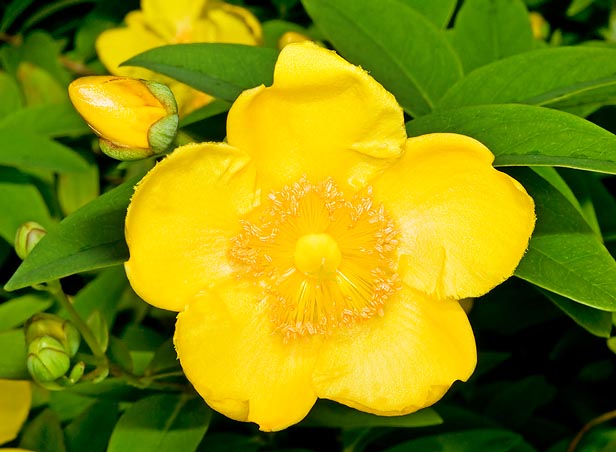Family : Hypericaceae

Text © Pietro Puccio

English translation by Mario Beltramini

The Hypericum hookerianum is a small garden shrub with medical properties © Giuseppe Mazza
The name of the genus is the combination of the Greek words “hyper” = over, and “eikon” = image, of unclear reference; the species is honoured to the English botanist William Jackson Hooker (1785-1865).
Common names: Hooker’s St. Johnswort (English).
The Hypericum hookerianum Wight & Arn. (1834) is a perennial, compact and roundish, evergreen, shrub, semi-deciduous in the cooler areas, rather variable, 1-1,5 m tall, with cylindrical stems, at times flattened when young. The leaves are opposite on a short petiole, from lanceolate to ovate, 2-7 cm long and 1-3 cm broad, of an intense green colour on the upper page, pale green or glaucous below. The inflorescences are apical and carry from one to five cup-shaped flowers, of 3-6 cm of diameter, of a colour going from the pale to intense yellow, with roundish petals and numerous stamens. The fruits are ovoid, 1-1,7 cm long, capsules, containing 1 mm reddish brown seeds.
It reproduces by seed, division and cutting. It is a much appreciated species due to its long and showy blooming which lasts from summer to autumn, suitable for edges, soil covering, and isolated spots, in full sun or in partial shade. It may grow up in an ample variety of climates, in particular the cooler ones, as it may resist, after what reported in literature, to temperatures of the order of -30° C. It is not too demanding for what the soil is concerned; watering must be regular all over the summertime. It can be cultivated in pot in draining and rich of humus soil, for the decoration of open luminous spaces; the periodical prunings are useful for keeping compact its carriage.
Laboratory studies have shown that extracts of leaves and branches hold interesting anti-bacterial, antitumor and anti-oxidant properties.
Synonyms: Norysca hookeriana (Wight & Arn.) Wight (1840); Hypericum patulum var. hookerianum (Wight & Arn.) Kuntze (1891).
→ To appreciate the biodiversity within the HYPERICACEAE family please click here.
